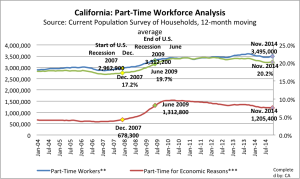
Last week the latest Job Openings and Labor Turnover Survey (JOLTS) was issued by the Bureau of Labor Statistics (for data through November 2014). It includes key employment indicators of job openings and job openings per job seeker. It builds on November 2014 data released earlier for the key state employment indicators of unemployment rate, payroll job numbers, labor force participation rate, and the little-known but important indicator of involuntary part-time employment (chart below).
 So what do we see in these five major monthly employment indicators? We continue to see cross-currents: one current of strong payroll job growth, low unemployment rate, and high numbers of job openings (both absolutely, and in proportion to job seekers); another current of a labor force participation rate in California that has sunk to among the lowest levels since the late 1970s, and an involuntary part-time employment rate that is among the highest of the past three decades. Added to these five indicators is a sixth, the wage levels of jobs being created.
So what do we see in these five major monthly employment indicators? We continue to see cross-currents: one current of strong payroll job growth, low unemployment rate, and high numbers of job openings (both absolutely, and in proportion to job seekers); another current of a labor force participation rate in California that has sunk to among the lowest levels since the late 1970s, and an involuntary part-time employment rate that is among the highest of the past three decades. Added to these five indicators is a sixth, the wage levels of jobs being created.
- State Unemployment Rate: The latest state unemployment rate is 7.2% through November 2014, a far cry from the 12.3% rate in November 2010, and even the 8.4% in November 2013.
- Payroll Job Gains: California payrolls increased by a near-unprecedented 90,100 jobs during the month. The payroll gains reached 344,000 over the year and 1.529,500 since February 2010.
- Number of job openings (absolute and in proportion to job seekers): The job openings on the state level are not yet available for November, but usually total around 11% of the national total. In November, on the national level the job openings on any given day was estimated at 5 million, the highest in fourteen years, with an similar estimated 5 million hires in November. Translated to California, this would mean around 550,000 hires in November in California. The number of unemployed persons per job opening fell to a pre-recession level of 1.8
- Labor force participation rate: The indicators of the unemployment rate and the number of unemployed persons per job opening both are linked to the labor force participation rate. The latest labor force participation rate for November is 62.5%, slightly above the October rate, but among the lowest rates since the late 1970s in our state.
- Involuntary part time employment: The very valuable chart above, prepared by Brandon Hooker of EDD shows the rate of the part time work force. A good number of workers today, as in the past, prefer part-time work due to school, or family obligations, or avocations. But a key employment indicator is the number of persons working “part time for economic reasons”, meaning that they seek full time work but cannot find it. This number grew from around 600,000 in California in January 2007, prior to the Great Recession, and reached over 1.5 million in November 2010. It has since gone down, but at 1.2 million is still way above pre-Great Recession levels.
Neither the BLS nor EDD monthly data capture the distribution of wage levels. But Chris Kirkham of the Los Angeles Times has been covering low wage job growth in Southern California (here and here). Further, the low wage job growth is a subject that continues to be tracked by the California Budget Project, as well as Carol Zabin and others at the UC Berkeley Center for Labor Research and Education.
So there is no easy description of our California employment dynamic in early 2015. Indicators continue to move in different directions.
http://www.foxandhoundsdaily.com/2015/01/tracking-5-major-employment-indicators-california/

